Minerals and Rocks of the Earth’s Crust
What lies deep within the Earth? Our planet has a central core with several layers, or shells, surrounding it. The densest matter is at the center, and each layer above it is increasingly less dense.
THE EARTH'S INTERIOR
Our planet is almost spherical, with a radius of approximately 6400 km (about 4000 mi). Its central core is about 3500 km (about 2200 mi) in radius (Figure 11.1). We know that the outer core is liquid from measurements of earthquake waves passing through the Earth, which suddenly change behavior when they reach the core. But the innermost part of the core is solid and made mostly of iron, with some nickel. The core is very hot—somewhere between 3000°C and 5000°C (about 5400°F to 9000°F).
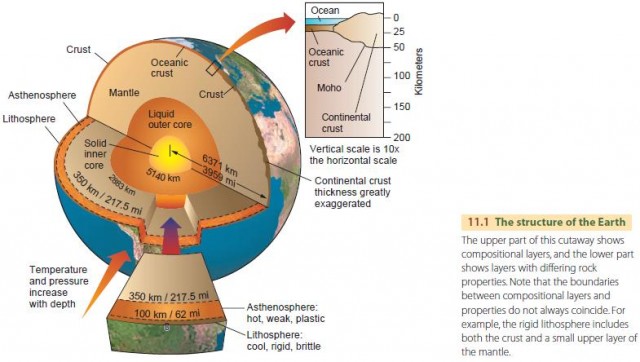
The core is surrounded by the mantle—a shell about 2900 km (about 1800 mi) thick. Mantle temperatures range from about 2800°C (about 5100°F) near the core to about 1800°C (about 3300°F) near the crust. The mantle is composed of ultramafic rock, which is made up of the densest forms of iron and magnesium combined with silicon and oxygen.
The thin, outermost layer of our planet is the Earth's crust. This skin of varied rocks and minerals ranges from about 8 to 40 km (about 5 to 25 mi) thick and contains the continents and ocean basins. It is the source of soil on the lands, salts in the sea, gases in the atmosphere, and of all the water of the oceans, atmosphere, and lands.
The base of the crust is sharply defined where it contacts the mantle. This contact is detected by the way in which earthquake waves abruptly change velocity at that level. The boundary surface between crust and mantle is called the Moho, a simplification of the name of the scientist, Andrija Mohorovicic, who discovered it in 1909.
The crust that lies below ocean floors—oceanic crust—consists almost entirely of silicates of magnesium and iron—mafic rocks. But the continental crust consists of two continuous zones—an upper zone of rocks that are less dense and are composed of silicates of aluminum, sodium, potassium, and calcium—felsic rocks—and a lower zone of denser, mafic rock. Another key distinction between continental and oceanic crust is that the crust beneath the continents is much thicker—35 km (22 mi) on average—than it is beneath the ocean floors, where it is typically 7 km (4 mi).
MINERALS AND ROCKS
Minerals are naturally occurring inorganic substances, often with a crystalline structure. They are composed largely of the most abundant elements in the Earth's crust, silicon and oxygen, coupled with metals or the metallic elements of iron, calcium, sodium, potassium, and magnesium.
Rocks are usually composed of two or more minerals. Often, many different minerals are present, but a few rock varieties are made almost entirely of one mineral. Most rock in the Earth's crust is extremely old, dating back many millions of years, but rock is also being formed at this very hour as active volcanoes emit lava that solidifies on contact with the atmosphere or ocean.
Rocks fall into three major classes: (1) igneous, (2) sedimentary, and (3) metamorphic rocks. The three classes of rocks are constantly being transformed from one to another in a continuous process through which the crustal minerals have been recycled during many millions of years of geologic time. Figure 11.3 diagrams these transformations.
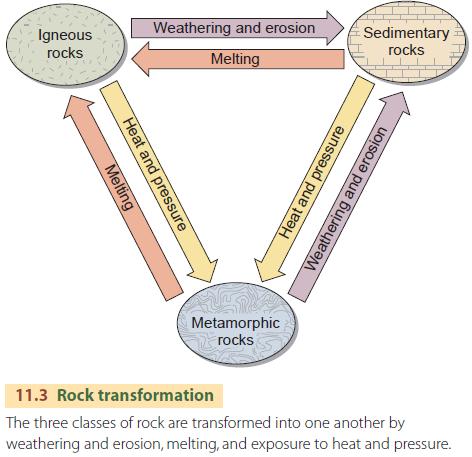
In the process of melting, preexisting rock of any class is melted and then later cools to form igneous rock. In weathering and erosion, preexisting rock is broken down and accumulated in layers that become sedimentary rock. Heat and pressure convert igneous and sedimentary rocks to metamorphic rock. We will return to this cycle later in the chapter, after we have taken a more detailed look at rocks, minerals, and their formation processes.
IGNEOUS ROCKS
Igneous rocks are formed when molten material, or magma, solidifies. The magma moves upward from pockets a few kilometers below the Earth's surface, through fractures in older solid rock. There the magma cools, forming rocks of mineral crystals.
Most igneous rock consists of silicate minerals—chemical compounds that contain silicon and oxygen atoms. These rocks also contain mostly metallic elements. The mineral grains in igneous rocks are very tightly interlocked, and so the rock is normally very strong. Quartz, which is made of silicon dioxide (SiO2), is the most common mineral of all rock classes.
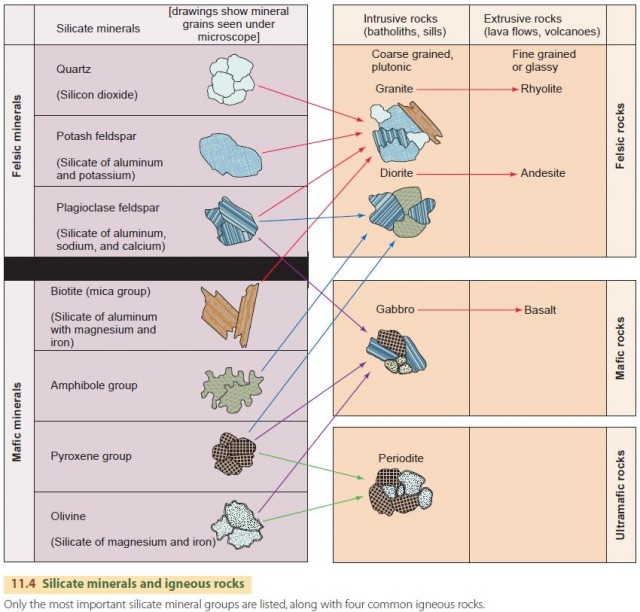
It is quite hard and resists chemical breakdown. Figure 11.4 shows some other common silicate minerals and the intrusive and extrusive rocks that are made from them. As noted earlier, silicate minerals in igneous rocks are classed as felsic, which are light- colored and less dense, and mafic, which are dark- colored and more dense. Felsic rock contains mostly felsic minerals, and mafic rock contains mostly mafic minerals. Ultramafic rock is dominated by two heavy mafic minerals and is the densest of the three rock types. Three common igneous rocks shown in the figure are granite (felsic, intrusive); andesite (felsic, extrusive); and basalt (mafic, intrusive).
Magma that solidifies below the Earth's surface and remains surrounded by older, preexisting rock is called intrusive igneous rock. Because intrusive rocks cool slowly, they develop mineral crystals visible to the eye. If the magma reaches the surface and emerges as lava, it forms extrusive igneous rock. Extrusive igneous rocks cool very rapidly on the land surface or ocean bottom and thus show crystals of only microscopic size. You can see formation of extrusive igneous rock today where volcanic processes are active (Figure 11.5).
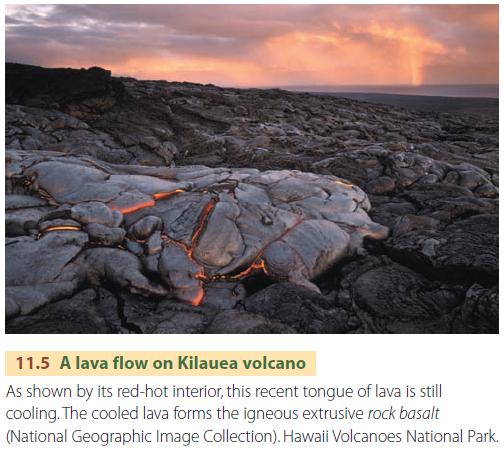
A body of intrusive igneous rock is called a pluton. Granite typically accumulates in enormous plutons, called batholiths. Figure 11.6 shows the relationship of a batholith to the overlying rock. As the hot fluid magma rises, it melts and incorporates the older rock lying above it. A single batholith extends down several kilometers and may occupy an area of several thousand square kilometers. Figure 11.6 shows other common forms of plutons.
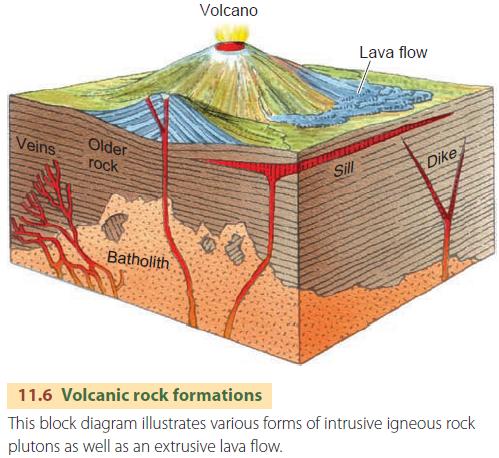
One is a sill, a plate-like layer formed when magma forces its way between two preexisting rock layers. In the example shown, the sill has lifted the overlying rock layers to make room. A second kind of pluton is the dike, a wall-like body formed when a vertical rock fracture is forced open by magma (Figure 11.7).
These vertical fractures conduct magma to the land surface in the process of extrusion. The dike rock is fine- textured because of its rapid cooling. Magma entering small, irregular, branching fractures in the surrounding rock solidifies in a branching network of thin veins.
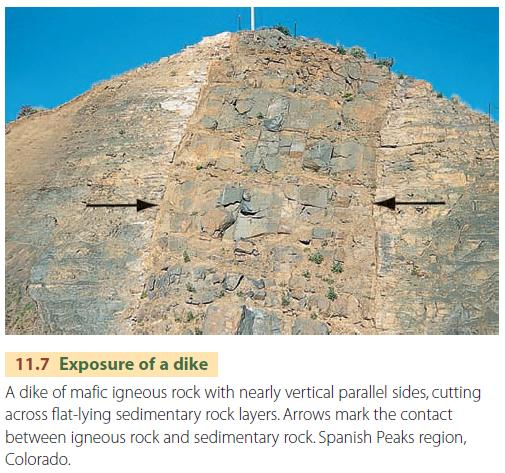
SEDIMENTS AND SEDIMENTARY ROCKS
Now let's turn to the second rock class, the sedimentary rocks. Sedimentary rocks are made from layers, or strata, of mineral particles found in other rocks that have been weathered and from newly formed organic matter. Most inorganic minerals in sedimentary rocks are from igneous rocks.
When rock minerals are weathered, their chemical composition is changed, weakening the solid rock. The rock breaks up into particles of many sizes. When these particles are transported in a fluid—air, water, or glacial ice—we call them sediment. Streams and rivers carry sediment to lower land levels, where it builds up. Most sediments accumulate on shallow seafloors bordering continents, but they also collect in inland valleys, lakes, and marshes. Wind and glacial ice are two other agents of transportation that can move sediment. Over long spans of time, the sediments become compacted and harden to form sedimentary rock, with distinctive visible characteristics.
There are three major classes of sediment: clastic sediment, chemically precipitated sediment, and organic sediment (Figure 11.8). Clastic sediment is made up of inorganic rock and mineral fragments, called clasts. These can come from igneous, sedimentary, or metamorphic rocks, and so they can include a very wide range of minerals.

Quartz and feldspar usually dominate clastic sediment. The size of the clastic sediment particles determines how easily and how far they are transported by water currents. Fine particles are easily suspended in fluids, while coarse particles tend to settle to the bottom. In this way, particles of different sizes are sorted in the fluid.
When layers of clastic sediment build up, the lower strata are pushed down by the weight of the sediments above them. This pressure compacts the sediments, squeezing out excess water. Dissolved minerals recrystallize in the spaces between mineral particles in a process called cementation. Figure 11.9 shows some important varieties of clastic sedimentary rocks. Sandstone, a rock made of sand, and shale, a rock made of clay particles, are typical examples.
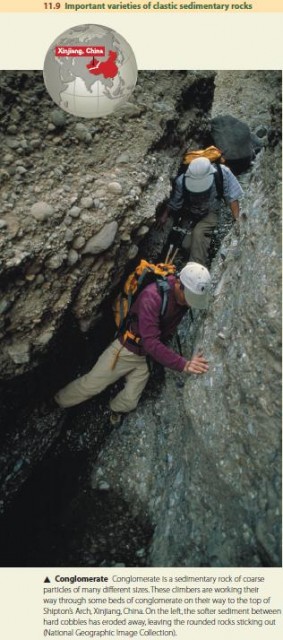
Chemically precipitated sediment is made of solid inorganic mineral compounds that precipitate from water solutions or are formed by organisms living in water. One of the most common sedimentary rocks formed by chemical precipitation is limestone. The third class of sediment is organic sediment. This is made up of the tissues of plants and animals. Peat is an example of an organic sediment. This soft, fibrous, brown or black substance accumulates in bogs and marshes where the water stops the plant or animal remains from decaying.
Peat is a compound of hydrogen, carbon, and oxygen. Hydrocarbon compounds such as this are the most important type of organic sediment—one that we increasingly depend on for fuel. They formed from plant remains that built up over millions of years and were compacted under thick layers of inorganic clastic sediment. Hydrocarbons can be solid (peat and coal), liquid (petroleum), or gas (natural gas). Coal is the only hydrocarbon that is a rock (Figure 11.11). We often find natural gas and petroleum in open interconnected pores in a thick sedimentary rock layer, such as in a porous sandstone (Figure 11.11).

These fossil fuels, as they are known, took millions of years to build up. But our industrial society is consuming them rapidly. They are nonrenewable resources—once they are gone, there will be no more. Even if we wait another thousand years for more fossil fuels to be created, the amount we gain will scarcely be measurable in comparison to the stores produced in the geologic past.
METAMORPHIC ROCKS
The mountain-building processes of the Earth's crust involve tremendous pressures and high temperatures. These extreme conditions alter igneous or sedimentary rocks, transforming them into metamorphic rock . In many cases, the mineral components of the parent rock are changed into different mineral varieties. In some cases, the original minerals may recrystallize.
Extreme heat and pressure transform shale into slate or schist, sandstone into quartzite, and limestone into marble. Gneiss forms when an intrusive magma cools next to igneous or sedimentary rocks.
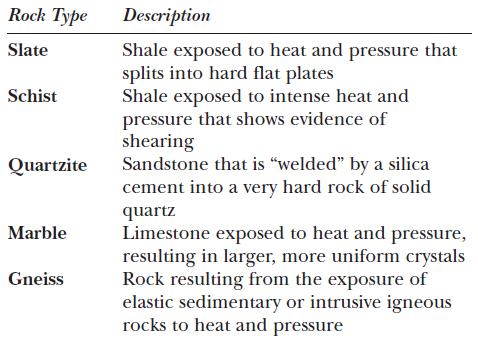
THE CYCLE OF ROCK CHANGE
The processes that form rocks, when taken together, constitute a single system that cycles and recycles Earth materials over geologic time from one form to another. The cycle of rock change, shown in Figure 11.13, describes this system.
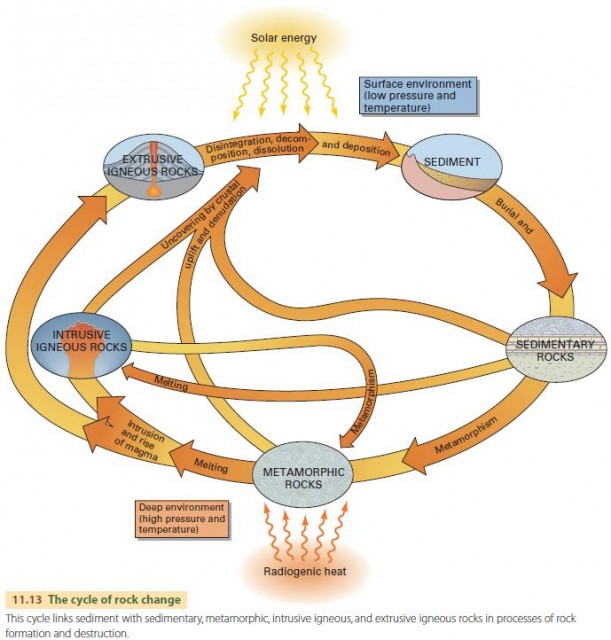
There are two environments—a surface environment of low pressures and temperatures and a deep environment of high pressures and temperatures. The surface environment is the site of rock alteration and sediment deposition. Here, igneous, sedimentary, and metamorphic rocks are uplifted and exposed to air and water. Their minerals are altered chemically and broken free from the parent rock, yielding sediment. The sediment accumulates in basins, where deeply buried sediment layers are compressed and cemented into sedimentary rock.
Sedimentary rock, entering the deep environment, is heated and comes into a zone of high confining pressure. Here, it is transformed into metamorphic rock. Pockets of magma are formed in the deep environment and move upward, melting and incorporating surrounding rock as they rise.
Upon reaching a higher level, magma cools and solidifies, becoming intrusive igneous rock, which reaches the surface environment when it is uncovered by erosion. Or it may emerge at the surface to form extrusive igneous rock. Either way, the cycle is completed.
The cycle of rock change has been active since our planet became solid and internally stable, continuously forming and re-forming rocks of all three major classes. Not even the oldest igneous and metamorphic rocks found so far are the “original” rocks of the Earth's crust. These were recycled eons ago.
THE GEOLOGIC TIME SCALE
So far we've talked about how rocks are formed. Soon we will look at how many of the features on the Earth's surface developed—including mountains, oceans basins, and the continents themselves. All of these formation processes took place over millions of years, and in our discussion we will need to refer to some major units of the geologic time scale. Figure 11.14 maps out the major divisions of geologic time. The longest unit is the eon. Next is the era, followed by the period and the epoch.
A very important benchmark in the geologic time scale is the Cambrian period, when life on Earth began to flourish. In Precambrian time, life had early beginnings but is generally absent from the geologic record. Nearly all the landscape features visible today have been formed within the Cenozoic era, which is the most recent era.
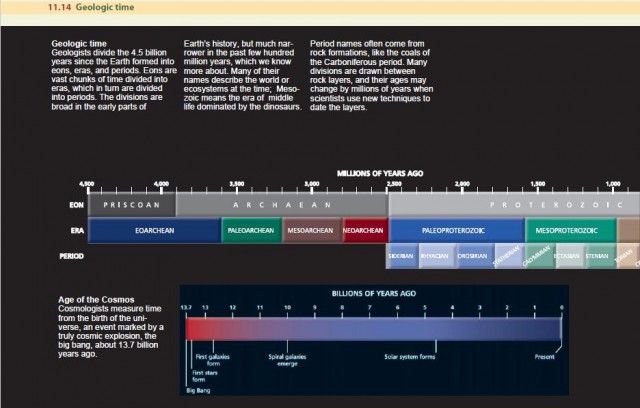
If you think of the history of the Earth since its formation as spanning a single 24-hour day, you can place the age of each geologic time division on a 24-hour time scale. Precambrian time ends at about 21:10. That means that life only proliferated on Earth during the last 2 hours and 50 minutes of this day. The human genus itself arises at about 30 seconds before midnight, and the last 5000 years of human civilization would occupy about half a second—truly a fleeting moment in our planet's vast history.